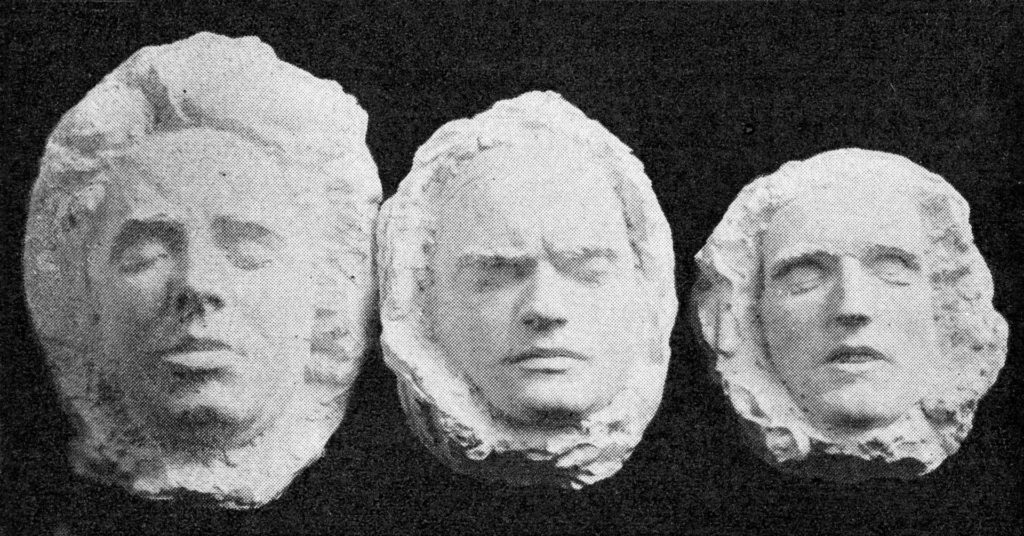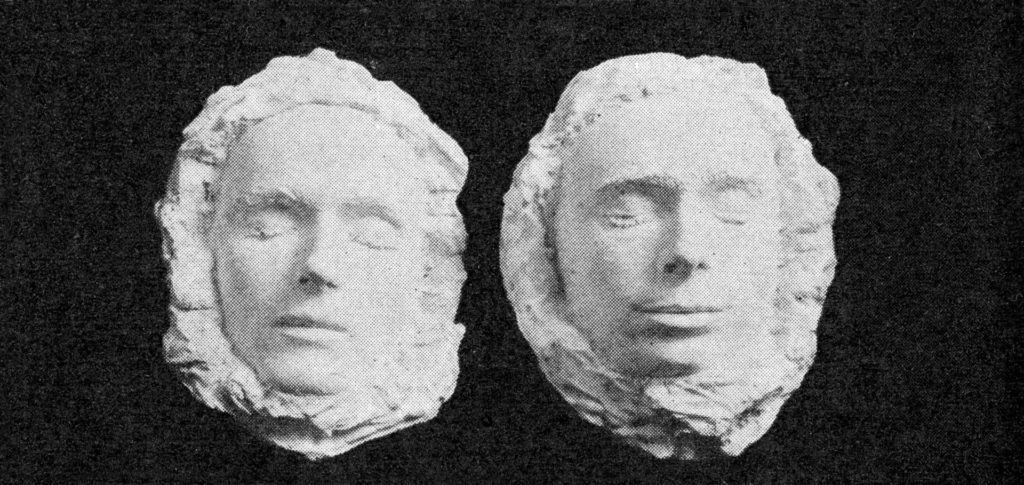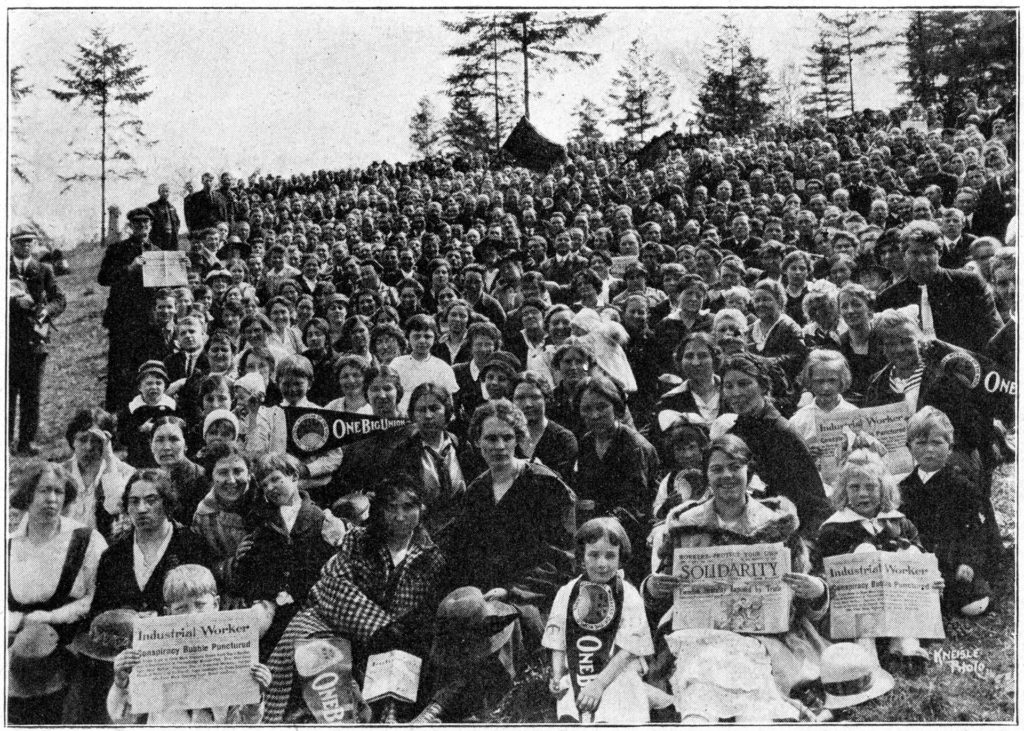289
CHAPTER IX.
SOLIDARITY SCORES A SUCCESS
“I. W. W. Not Guilty!”
In this headline the daily papers of Seattle, Washington, gave the findings of the jury. With an unbroken series of successful prosecutions of Labor to the credit of the Merchants and Manufacturers Association this, the first great victory for the working class on the Pacific Coast, was a bitter pill for the allied employers and open shop interests to swallow.
With Tracy freed and the I. W. W. exonerated, there was nothing for the Snohomish County officials to do but to release the rest of the free speech prisoners. Yet the same contemptible spirit that had marked their actions from the very start of the trouble led them to hold the prisoners for several days and to try to make a few of the men think that there would be a trial of a second prisoner.
Part of the men were released in Seattle and part in Everett. All went at once to the I. W. W. hall upon gaining their freedom, and from there nearly the whole body of released men went to Mount Pleasant cemetery to visit the graves of their dead fellow workers.
Returning to the hall, those who had previously been delegates, or who had fitted themselves for the work while in jail, immediately took out credentials and started on an organizing campaign of the Northwest, with the uniting of the workers in the lumber industry as their main object.
The dearth of workers due to the war, the tremendous advertisement the I. W. W. had received because of the tragedy and the trial, and the spirit of mingled determination and resentment that had grown up in the jail, made the work easy for these volunteer organizers. Members joined by the dozen, then by the score, and finally by the hundreds.
290

Gus Johnson Felix Baran John Looney

Hugo Gerlot Abraham Rabinowitz
291
Seattle had but two officials under pay on November 5th—Herbert Mahler, secretary of the I. W. W., and J. A. MacDonald, editor of the Industrial Worker. By July 4th, 1917, one year from the time of the loggers’ convention at which there were only half a hundred paid up members, the I. W. W. in Seattle had thirty people under pay, working at top speed to take care of the constantly increasing membership, and preparations were under way to launch the greatest lumber strike ever pulled in the history of the industry with the eight hour day as the main demand. That strike in which thousands of men stood out for week after week in the face of persecution of every character, in the face of raids upon their halls and the illegal detention of hundreds of members by city, county, state and federal agents, and in the face of deportations by mobs of lumber trust hirelings, deserves a volume to itself.
This activity in the lumber industry reflected itself in all other lines, particularly so in construction projects all over the Northwest. Demands for literature, for speakers, for organizers, flooded the offices of the organization and many opportunities to organize had to be passed by simply because there were not enough men capable of taking up the work.
Part of this growth was of those who had interested themselves in the trial. Many of those who had gone on the witness stand for the defense afterwards took out membership cards in the I. W. W. The women of Everett,—considerably more inclined toward revolutionary ideas than the men there, by the way,—were among the first to ask for a “red card.”
Too great praise cannot be given to those who voluntarily gave their services to the defense and thus helped to bring about a verdict of acquittal. Thru the work of Mr. A. L. Carpenter a great deal of valuable information was secured and it was thru his efforts that Deputy Joseph Schofield was brought from Oregon to testify for the defense. For his activity on behalf of organized labor Mr. Carpenter received the rebel’s reward—he was discharged from
292
his position as district manager of a large corporation. Scores of Everett citizens gave splendid assistance to the defense, asking only that their names be withheld on account of the Commercial Club blacklist.
All persons directly in the employ of the defense proved their worth. Deserving special mention in their work of investigation were Rev. T. T. Edmunds, W. A. Loomis and John M. Foss. The Reverend Edmunds, being no follower of a “cold statistical Christ” and having more of humanitarianism than theology or current religion in his makeup, was able to gain information where many another investigator might have failed. The expert services of Loomis were of no less value, while the particular merit of the work of John Foss was that he went to Everett immediately after the catastrophe, at a time when chaos still reigned and when the blood-lust of the deputies had not yet completely given way to craven fear, and worked there night and day until a verdict of acquittal for his fellow workers was practically assured. Both as an investigator and as correspondent to the I. W. W. press, C. E. Payne, familiarly known as “Stumpy,” proved himself invaluable. Charles Ashleigh handled the publicity for the Everett Prisoners’ Defense Committee in an able and efficient manner, while to Herbert Mahler credit is due for the careful and painstaking handling of the large fund raised to fight the case thru the courts.
“Justice” is an expensive luxury in the lumber kingdom. Independent of the large amount of money spent directly by individuals and by branches of the I. W. W. the cost of the verdict of acquittal was $37,835.84. Nearly thirty-eight thousand dollars! Thirty-eight thousand dollars to free innocent workers from the clutches of the law! The victims in jail and the murderers at liberty! But then, the last thing expected of “Justice” is that it be just.
Whence came the fund that, as a token of solidarity, set the free speech prisoners at liberty? In the financial statement of the Everett Prisoners Defense Committee it is set forth in full. Summarized, this
293
report shows that Labor united in the defense of the prisoners, that, while this case was more largely financed directly thru the I. W. W. than any other trial of the organization, there were many and generous contributions from local unions of the American Federation of Labor, from the Workers’ Sick and Death Benefit Fund, from various other working class societies and from sources so numerous as to make special mention impossible. But these receipts varied from a dollar bill sent by “A poor Working Stiff” from North Bend, Oregon, to a donation of $3.75 from the Benevolent Society for the Propagating of Cremation at Yonkers, New York.
Hundreds of dollars were raised in Seattle by the I. W. W. thru smokers, dances, theatrical benefits, entertainments and collections by speakers who told the story of Bloody Sunday before societies of every kind and character. The Dreamland Rink meetings, attended in every instance by thousands of people, were the means of bringing hundreds of dollars to the defense. A considerable fund was raised directly within the organization by the sale of embossed leatherette membership card cases issued in memoriam to the martyred dead. In Seattle notable service was rendered by the International Workers’ Defense League.
294

May First at Graveside of Hugo Gerlot, Baran and Looney.
The nature of the case demanded heavy expenditures unlike those required in any of the previous trials in which I. W. W. members were involved. Many of the witnesses were men who had beaten their way from long distances thru storms and snow to be in readiness to testify in behalf of their imprisoned fellow workers, and most of these had to be maintained at a relief station until called upon the stand. The care of the wounded was an added item, and there were many necessary expenditures for the big body of prisoners held as defendants. To each of the men who was released at the end of the six months imprisonment there was given a sum of $10. Owing to the sweeping nature of the conspiracy charges and because of the large number of witnesses endorsed by the State, all of whom
295
required investigation, there was a large sum required for use in taking these necessary legal precautions. Heavy charges were also made for the work of the stenographers who recorded the evidence, this being an item borne by the State in most parts of the country. The totals of these expenditures were as follows:
Counsel fees in full
Legal investigation
Court stenographers
Miscellaneous legal expense
Office expense
Publicity work
Miscellaneous accounts
Total expenditures
$8,470.00
8,955.36
3,354.30
1,304.20
1,942.53
4,830.44
8,457.37
—————
$37,314.20
A balance of $521.64 was sent to the General Headquarters of the I. W. W. and this, with $581.36 which remained in the General Office from the sale of voluntary assessment stamps, was set aside as a fund to be used for the maintenance of Harry Golden, Joseph Ghilezano and Albert Scribner, three of the boys who were seriously injured on the Verona.
The financial report was audited by E. G. Shorrock and Co., certified accountants, and by a committee composed of Harry Feinberg and J. H. Beyer, representing the prisoners, C. H. Rice, representing the Seattle unions of the I. W. W., and General Executive Board member, Richard Brazier, representing the General Headquarters of the I. W. W. The statement made to contributors to the fund concluded with these expressive words:
“On behalf of the defendants, and the Industrial Workers of the World, we take this opportunity to express our grateful appreciation to all contributors, and to all the brave men and women who assisted us so nobly in this great struggle to save seventy-three workingmen from a living death at the hands of the Lumber Trust and the allied commercial bodies of the Pacific Coast.
296
“It was the solidarity of the working class, and that alone, which brought about this great victory for labor, so let us turn fresh from victory, with determined hearts and unquellable spirit to unflinchingly continue the struggle for the liberation of all prisoners of the class war, remembering always that greatest expression of solidarity, ‘An injury to one, is an injury to all.’
“THE EVERETT PRISONERS DEFENSE
COMMITTEE.
THOMAS MURPHY,
CHARLES ASHLEIGH,
WM. J. HOUSER,
RICHARD SMITH,
HERBERT MAHLER, Sec’y-Treas.”
Seattle, Wash.,
June 12th, 1917.